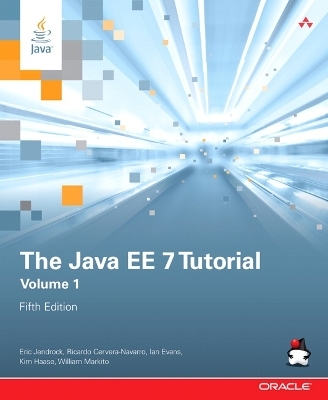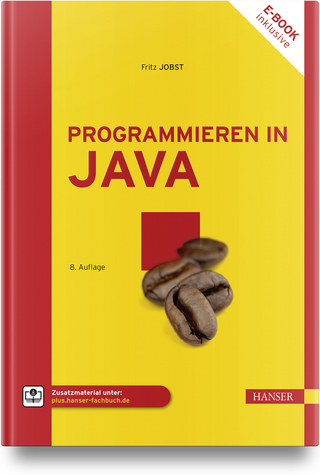
Java EE 7 Tutorial, The, Volume 1
Addison-Wesley Educational Publishers Inc (Verlag)
978-0-321-99492-9 (ISBN)
This guide includes descriptions of platform features and provides instructions for using the latest versions of NetBeans IDE and GlassFish Server Open Source Edition. The book introduces platform basics, including resource creation, resource injection, and packaging. It covers JavaServer Faces, Java Servlets, the Java API for WebSocket, the Java API for JSON Processing (JSON-P), internationalization and localization, Bean Validation, Contexts and Dependency Injection for Java EE (CDI), and web services (JAX-WS and JAX-RS).
Eric Jendrock leads the Java EE Tutorial team at Oracle and documented Java Servlet technology as well as internationalization and localization. Ricardo Cervera-Navarro documented resource injection, WebSocket, JSON-P, and JAX-RS, and contributed Java Servlet examples. Ian Evans documented Bean Validation, JAX-RS, and JAX-WS. Kim Haase documented JavaServer Faces technology and CDI. William Markito, a former member of the Platform Technology Solutions group at Oracle, created examples for several technologies.
Preface xxix
Part I: Introduction 1
Chapter 1: Overview 3
1.1 Java EE 7 Platform Highlights 4
1.2 Java EE Application Model 5
1.3 Distributed Multitiered Applications 6
1.4 Java EE Containers 13
1.5 Web Services Support 15
1.6 Java EE Application Assembly and Deployment 17
1.7 Development Roles 17
1.8 Java EE 7 APIs 20
1.9 Java EE 7 APIs in the Java Platform, Standard Edition 7 30
1.10 GlassFish Server Tools 33
Chapter 2: Using the Tutorial Examples 35
2.1 Required Software 35
2.2 Starting and Stopping GlassFish Server 39
2.3 Starting the Administration Console. 40
2.4 Starting and Stopping the Java DB Server 40
2.5 Building the Examples 41
2.6 Tutorial Example Directory Structure 41
2.7 Java EE 7 Maven Archetypes in the Tutorial 42
2.8 Getting the Latest Updates to the Tutorial 43
2.9 Debugging Java EE Applications 44
Part II: Platform Basics 47
Chapter 3: Resource Creation 49
3.1 Resources and JNDI Naming 49
3.2 DataSource Objects and Connection Pools 50
3.3 Creating Resources Administratively 51
Chapter 4: Injection 53
4.1 Resource Injection 53
4.2 Dependency Injection 54
4.3 The Main Differences between Resource Injection and Dependency Injection 55
Chapter 5: Packaging 57
5.1 Packaging Applications 57
5.2 Packaging Enterprise Beans 59
5.3 Packaging Web Archives 61
5.4 Packaging Resource Adapter Archives 63
Part III: The Web Tier 65
Chapter 6: Getting Started with Web Applications 67
6.1 Web Applications 68
6.2 Web Application Lifecycle 69
6.3 A Web Module That Uses JavaServer Faces Technology: The hello1 Example 70
6.4 A Web Module That Uses Java Servlet Technology: The hello2 Example 77
6.5 Configuring Web Applications 81
6.6 Further Information about Web Applications 86
Chapter 7: JavaServer Faces Technology 87
7.1 What Is a JavaServer Faces Application? 88
7.2 JavaServer Faces Technology Benefits 89
7.3 A Simple JavaServer Faces Application 91
7.4 User Interface Component Model 92
7.5 Navigation Model 100
7.6 The Lifecycle of a JavaServer Faces Application 103
7.7 Partial Processing and Partial Rendering 110
7.8 Further Information about JavaServer Faces Technology 110
Chapter 8: Introduction to Facelets 111
8.1 What Is Facelets? 112
8.2 The Lifecycle of a Facelets Application 114
8.3 Developing a Simple Facelets Application: The guessnumber-jsf Example Application 115
8.4 Using Facelets Templates 121
8.5 Composite Components 124
8.6 Web Resources 127
8.7 Relocatable Resources 128
8.8 Resource Library Contracts 128
8.9 HTML5-Friendly Markup 132
Chapter 9: Expression Language 141
9.1 Overview of the EL 141
9.2 Immediate and Deferred Evaluation Syntax 142
9.3 Value and Method Expressions 144
9.4 Operations on Collection Objects 151
9.5 Operators 153
9.6 Reserved Words 154
9.7 Examples of EL Expressions 154
9.8 Further Information about the Expression Language 155
Chapter 10: Using JavaServer Faces Technology in Web Pages 157
10.1 Setting Up a Page 158
10.2 Adding Components to a Page Using HTML Tag Library Tags 159
10.3 Using Core Tags 192
Chapter 11: Using Converters, Listeners, and Validators 197
11.1 Using the Standard Converters 198
11.2 Registering Listeners on Components 203
11.3 Using the Standard Validators 207
11.4 Referencing a Managed Bean Method 209
Chapter 12: Developing with JavaServer Faces Technology 213
12.1 Managed Beans in JavaServer Faces Technology 213
12.2 Writing Bean Properties 216
12.3 Writing Managed Bean Methods 226
Chapter 13: Using Ajax with JavaServer Faces Technology 231
13.1 Overview of Ajax 232
13.2 Using Ajax Functionality with JavaServer Faces Technology 233
13.3 Using Ajax with Facelets 233
13.4 Sending an Ajax Request 236
13.5 Monitoring Events on the Client 238
13.6 Handling Errors 238
13.7 Receiving an Ajax Response 239
13.8 Ajax Request Lifecycle 240
13.9 Grouping of Components 240
13.10 Loading JavaScript as a Resource 241
13.11 The ajaxguessnumber Example Application 243
13.12 Further Information about Ajax in JavaServer Faces Technology 247
Chapter 14: Composite Components: Advanced Topics and an Example 249
14.1 Attributes of a Composite Component 249
14.2 Invoking a Managed Bean 251
14.3 Validating Composite Component Values 251
14.4 The compositecomponentexample Example Application 251
Chapter 15: Creating Custom UI Components and Other Custom Objects 257
15.1 Determining Whether You Need a Custom Component or Renderer 259
15.2 Understanding the Image Map Example 262
15.3 Steps for Creating a Custom Component 268
15.4 Creating Custom Component Classes 268
15.5 Delegating Rendering to a Renderer 278
15.6 Implementing an Event Listener 281
15.7 Handling Events for Custom Components 283
15.8 Defining the Custom Component Tag in a Tag Library Descriptor 284
15.9 Using a Custom Component 285
15.10 Creating and Using a Custom Converter 287
15.11 Creating and Using a Custom Validator 292
15.12 Binding Component Values and Instances to Managed Bean Properties 298
15.13 Binding Converters, Listeners, and Validators to Managed Bean Properties 303
Chapter 16: Configuring JavaServer Faces Applications 305
16.1 Using Annotations to Configure Managed Beans 306
16.2 Application Configuration Resource File 307
16.3 Using Faces Flows 311
16.4 Configuring Managed Beans 323
16.5 Registering Application Messages 332
16.6 Using Default Validators 335
16.7 Registering a Custom Validator 336
16.8 Registering a Custom Converter 337
16.9 Configuring Navigation Rules 337
16.10 Registering a Custom Renderer with a Render Kit 340
16.11 Registering a Custom Component 342
16.12 Basic Requirements of a JavaServer Faces Application 343
Chapter 17: Java Servlet Technology 351
17.1 What Is a Servlet? 352
17.2 Servlet Lifecycle 352
17.3 Sharing Information 354
17.4 Creating and Initializing a Servlet 356
17.5 Writing Service Methods 356
17.6 Filtering Requests and Responses 359
17.7 Invoking Other Web Resources 363
17.8 Accessing the Web Context 365
17.9 Maintaining Client State 365
17.10 Finalizing a Servlet 367
17.11 Uploading Files with Java Servlet Technology 370
17.12 Asynchronous Processing 372
17.13 Nonblocking I/O 375
17.14 Protocol Upgrade Processing 378
17.15 The mood Example Application 381
17.16 The fileupload Example Application 383
17.17 The dukeetf Example Application 388
17.18 Further Information about Java Servlet Technology 394
Chapter 18: Java API for WebSocket 395
18.1 Introduction to WebSocket 396
18.2 Creating WebSocket Applications in the Java EE Platform 397
18.3 Programmatic Endpoints 398
18.4 Annotated Endpoints 399
18.5 Sending and Receiving Messages 400
18.6 Maintaining Client State 402
18.7 Using Encoders and Decoders 403
18.8 Path Parameters 406
18.9 Handling Errors 407
18.10 Specifying an Endpoint Configurator Class 407
18.11 The dukeetf2 Example Application 408
18.12 The websocketbot Example Application 413
18.13 Further Information about WebSocket 420
Chapter 19: JSON Processing 421
19.1 Introduction to JSON 421
19.2 JSON Processing in the Java EE Platform 423
19.3 Using the Object Model API 425
19.4 Using the Streaming API 429
19.5 JSON in Java EE RESTful Web Services 431
19.6 The jsonpmodel Example Application 432
19.7 The jsonpstreaming Example Application 434
19.8 Further Information about the Java API for JSON Processing 436
Chapter 20: Internationalizing and Localizing Web Applications 437
20.1 Java Platform Localization Classes 437
20.2 Providing Localized Messages and Labels 438
20.3 Date and Number Formatting 441
20.4 Character Sets and Encodings 442
Part IV: Bean Validation 445
Chapter 21: Introduction to Bean Validation 447
21.1 Using Bean Validation Constraints 447
21.2 Validating Null and Empty Strings 450
21.3 Validating Constructors and Methods 451
21.4 Further Information about Bean Validation 454
Chapter 22: Bean Validation: Advanced Topics 455
22.1 Creating Custom Constraints 455
22.2 Customizing Validator Messages 457
22.3 Grouping Constraints 457
22.4 Using Method Constraints in Type Hierarchies 458
Part V: Contexts and Dependency Injection for Java EE 461
Chapter 23: Introduction to Contexts and Dependency Injection for Java EE 463
23.1 Getting Started 464
23.2 Overview of CDI 466
23.3 About Beans 467
23.4 About CDI Managed Beans 468
23.5 Beans as Injectable Objects 468
23.6 Using Qualifiers 469
23.7 Injecting Beans 470
23.8 Using Scopes 471
23.9 Giving Beans EL Names 473
23.10 Adding Setter and Getter Methods 473
23.11 Using a Managed Bean in a Facelets Page 474
23.12 Injecting Objects by Using Producer Methods 474
23.13 Configuring a CDI Application 475
23.14 Using the @PostConstruct and @PreDestroy Annotations with CDI Managed Bean Classes 476
23.15 Further Information about CDI 477
Chapter 24: Running the Basic Contexts and Dependency Injection Examples 479
24.1 The simplegreeting CDI Example 479
24.2 The guessnumber-cdi CDI Example 483
Chapter 25: Contexts and Dependency Injection for Java EE: Advanced Topics 493
25.1 Packaging CDI Applications 493
25.2 Using Alternatives in CDI Applications 494
25.3 Using Producer Methods, Producer Fields, and Disposer Methods in CDI Applications 497
25.4 Using Predefined Beans in CDI Applications 499
25.5 Using Events in CDI Applications 501
25.6 Using Interceptors in CDI Applications 504
25.7 Using Decorators in CDI Applications 506
25.8 Using Stereotypes in CDI Applications 507
Chapter 26: Running the Advanced Contexts and Dependency Injection Examples 511
26.1 The encoder Example: Using Alternatives 511
26.2 The producermethods Example: Using a Producer Method to Choose a Bean Implementation 517
26.3 The producerfields Example: Using Producer Fields to Generate Resources 520
26.4 The billpayment Example: Using Events and Interceptors 527
26.5 The decorators Example: Decorating a Bean 535
Part VI: Web Services 539
Chapter 27: Introduction to Web Services 541
27.1 What Are Web Services? 541
27.2 Types of Web Services 541
27.3 Deciding Which Type of Web Service to Use 544
Chapter 28: Building Web Services with JAX-WS 545
28.1 Creating a Simple Web Service and Clients with JAX-WS 546
28.2 Types Supported by JAX-WS 555
28.3 Web Services Interoperability and JAX-WS 557
28.4 Further Information about JAX-WS 558
Chapter 29: Building RESTful Web Services with JAX-RS 559
29.1 What Are RESTful Web Services? 559
29.2 Creating a RESTful Root Resource Class 561
29.3 Example Applications for JAX-RS 578
29.4 Further Information about JAX-RS 583
Chapter 30: Accessing REST Resources with the JAX-RS Client API 585
30.1 Overview of the Client API 585
30.2 Using the Client API in the JAX-RS Example Applications 589
30.3 Advanced Features of the Client API 592
Chapter 31: JAX-RS: Advanced Topics and an Example 597
31.1 Annotations for Field and Bean Properties of Resource Classes 598
31.2 Validating Resource Data with Bean Validation 601
31.3 Subresources and Runtime Resource Resolution 604
31.4 Integrating JAX-RS with EJB Technology and CDI 606
31.5 Conditional HTTP Requests 608
31.6 Runtime Content Negotiation 609
31.7 Using JAX-RS with JAXB 611
31.8 The customer Example Application 618
Index 627
| Erscheint lt. Verlag | 29.5.2014 |
|---|---|
| Reihe/Serie | Java Series |
| Verlagsort | New Jersey |
| Sprache | englisch |
| Maße | 190 x 230 mm |
| Gewicht | 1170 g |
| Themenwelt | Informatik ► Programmiersprachen / -werkzeuge ► Java |
| Mathematik / Informatik ► Informatik ► Web / Internet | |
| ISBN-10 | 0-321-99492-2 / 0321994922 |
| ISBN-13 | 978-0-321-99492-9 / 9780321994929 |
| Zustand | Neuware |
| Informationen gemäß Produktsicherheitsverordnung (GPSR) | |
| Haben Sie eine Frage zum Produkt? |
aus dem Bereich


